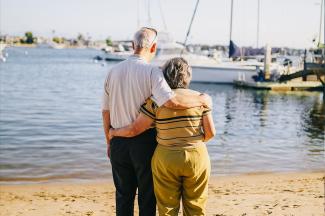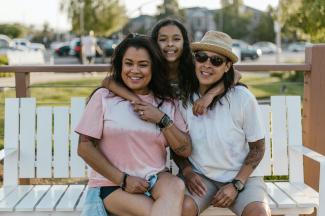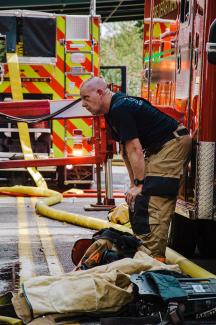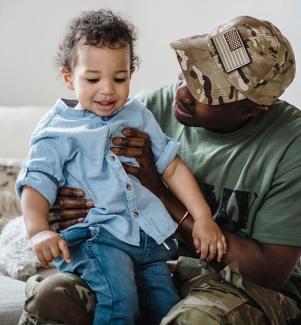Who is Most at Risk for Suicide in Rhode Island?

Suicide impacts everyone. Your age, race, or gender identity do not matter. But research tells us that some groups of people are more likely to attempt suicide.
It is important that the State gets help to communities and groups that are most at risk. Mental health services should provide the best, most culturally appropriate care for their clients. Some communities have had more trouble getting healthcare, have experienced prejudice, or have had more risk factors.
Read more below about groups of people at higher risk for attempting suicide.

Cisgender men are men whose gender identity is the same as what was assigned to them at birth. Cisgender men are more likely to die by suicide than cisgender women. Men age 35-64 are at the highest risk because:
- Men are less likely to get behavioral healthcare, like therapy, than women.*
- Men are more likely to use more violent lethal means, such as guns.
- The social expectations of masculinity can create greater isolation and increase other risk factors.

Transgender women, men, girls, boys, and non-binary people are people whose gender identity is not the same as what was assigned to them at birth. Transgender people are more likely to attempt and to die by suicide than cisgender people because:
- Transgender people may not have support or acceptance from their families.
- Transgender people may experience transphobia (prejudice against trans and non-binary people).
- The trauma of experiencing rejection and transphobia may lead to mental health struggles.*
- Transgender people may not have access to healthcare that supports their ability to live their authentic lives, also known as gender-affirming healthcare. More research is needed on the mental health and life experiences of transgender and non-binary people. Surveys often do not collect data on this group of people.
Learn about Rhode Island and national resources for LGBTQ+ people here.

Lesbian, gay, bisexual, and queer people are people whose romantic and sexual relationships are always or sometimes with people of the same gender as they are.
LGBQ people are more likely to attempt suicide than straight people because:
- LGBQ people may not have support or acceptance from their families.
- LGBQ people may experience homophobia or biphobia (prejudice against LGBQ people).
- The trauma of experiencing rejection and homophobia or biphobia may lead to mental health struggles.
Learn about Rhode Island and national resources for LGBTQ+ people here.

Suicide loss survivors are family and friends who have lost someone to suicide.
People who have lost a loved one to suicide have the same feelings as anyone who has lost a loved one: grief, loss, sadness, disbelief. Suicide loss survivors may also feel guilt, shame, anger, confusion, stigma, isolation, or a need to hide the cause of death.
Suicide loss survivors are more likely to have suicidal thoughts or attempt suicide because of family risk factors or due to the combination of grief, guilt, shame, and stigma.
Learn about resources for loss survivors in Rhode Island here.

Survivors of intimate partner or domestic violence are people who have experienced physical, emotional, sexual, or other types of abuse from a partner or family member.
Being attacked by someone you care about is traumatic. This kind of exposure to violence also makes a survivor more likely to attempt suicide. Violence can include domestic violence or intimate partner violence.
Learn about Rhode Island resources for survivors of domestic or intimate partner violence here.

Workers in high-risk professions are people who work in professions that put them at a higher risk for suicide. These people include doctors, first responders, firefighters, police officers, veterinarians, active-duty military, veterans, construction workers, and dentists.
They are at higher risk because:
- They see a lot of trauma at their job.
- They have easier access to means of suicide (guns and medicines)
- People who work in these jobs are more likely to also be a part of another high-risk group.
- The job involves a high likelihood of injury on the job that can cause temporary or permanent disability.
Learn about resources for people in high-risk professions here.

People of color is a general term for people who are not white, which includes many racial and ethnic groups.
Rates of suicide attempts and completions are different amongst communities of color, but many POC have experienced discrimination, trauma, and have limited access to culturally appropriate and respectful behavioral healthcare. These experiences may impact suicide risk.
American Indians/Alaska Natives have the highest suicide rate of any ethnic group.

Suicide attempt survivors are people who have attempted but survived a suicide attempt.
Most people who attempt suicide and survive do not go on to die by suicide. However, there are a small number of people that do. Of those that do, attempt survivors are most likely to attempt again within one year.

Service members are people currently serving in the armed forces. Veterans are people who have served in the U.S. Army, Navy, Air Force, Marine Corps, or Coast Guard.
Service members and veterans are more likely to attempt suicide than people who did not serve in the military. It is important that there is support for service members, veterans, and their families during and after their service to cope with the stresses and trauma of their work.

Youth are people younger than age 18. Young adults are people age 18-25.
Youth
While people younger than 18 are not the group most likely to die by suicide in Rhode Island, young people are more likely to have mental health issues that start when they are a teenager. Problems with mental health make someone more likely to attempt suicide.
Young Adults
A lot of people in this age group have depression and anxiety. More than half of college students say they have thought about suicide at some point in their lives.
The Rhode Island Young Adult Survey in 2020 revealed that 18-25-year old Rhode Islanders had high rates of mental illness, with 43.2% reporting symptoms of depression and 11.9% reporting having considered suicide in the past year.
Learn about Rhode Island and national resources for young people here.